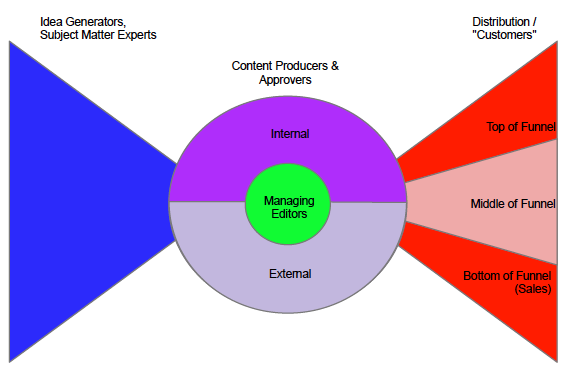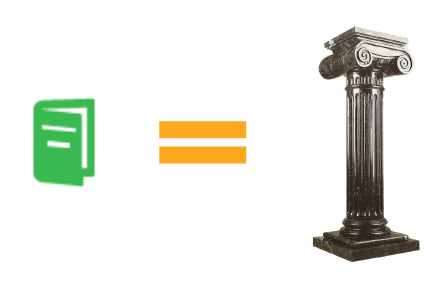By Anne Murphy, Managing Editor, Kapost
You understand why content is key for a successful marketing strategy, and you know that targeted, informative content is critical to fueling marketing automation campaigns. But the question remains: how can marketers build a sustainable, successful content marketing operation that produces quality content at scale?
By Anne Murphy, Managing Editor, Kapost
You understand why content is key for a successful marketing strategy, and you know that targeted, informative content is critical to fueling marketing automation campaigns. But the question remains: how can marketers build a sustainable, successful content marketing operation that produces quality content at scale?
{loadposition C2C13IAA}Building a content marketing strategy can be broken into five main steps: planning, people, ideation, production, and distribution. Understanding these steps and why they’re so important will help you to build a strategy that speaks to your organizations’ needs. At the end of this article, you’ll also find a Slideshare presentation with downloadable worksheets. If you’re serious about content marketing, complete the exercises outlined in these worksheets and you’ll end up with the framework and information you need to create a solid content marketing strategy–a strategy that reaches your target buyers and supports your organization’s goals
Planning
Define Your Content “Sweet Spot”: The best content comes from the intersection of two things: your buyer’s need and your organization’s expertise. When topics fit within both of these descriptions, those topics are within your content “sweet spot.” Everything from full E-books to single tweets should focus on those themes. Not only can your brand easily speak on those concepts with authority, but your buyers will find that content interesting, useful, and entertaining.
Define Personas: The next step is to understand your buyers, and an important part of understanding how to reach your buyers is understanding who they are. Define your key personas by mapping out the interests, challenges, goals, hopes and aspirations of your target buyers. This exercise will help you understand your buyer both professionally and personally, and will make it much easier for you to tailor content to their wants and needs.
Map Buying Stages: Next, identify the stages of your buying cycle and what topics or pieces of content are important at each of those stages. For example, common purchase funnel stages include awareness, research, consideration, purchase, and advocacy, but it may be different for your organization, Map out the journey your buyers take as they hear about, research and ultimately purchase your company’s product or service. Then, think through the kinds of information that matter at each of those stages, and what kind of content will encourage your buyers to move from one stage to the next.
People
Organize a Leadership Team: Every organization should have a single person organizing and managing the production of all content pieces, and making sure all of the moving pieces (and there are a lot) keep moving in a timely manner. Often, this role is given to the Managing Editor. It’s also crucial to have a leadership team or editorial board. These are the people who regularly review content metrics, absorb customer feedback, refine buyer personas and the content effective at each stage of the funnel, and help generate ideas for content themes and topics
Internal Content Contributors: As part of the team-building process, it’s crucial to understand who owns what responsibilities. When it comes to content, there may be different departments responsible for specific topics or types of content. Map out where all of your content will comes from and who will actually be producing that content. Then, where there are gaps, you can strategically look to external resources.
External Content Contributors: Often times, not everything can be done internally — especially as you start exploring different content types and topics. External contributors and freelancers are fabulous for ramping up your content marketing machine — and quickly. After mapping out content responsibilities and roles internally, look for the gaps and start filling them with qualified external contributors.
Ideation
Internal (Sales, Service, Support): Check in with the people who speak with customers and buyers every day. They are fantastic resources for content ideas. The sales, service (account management or customer success Teams) and support departments are three key groups for great content ideas. After all, they understand what clients care about, which topics matter most, and what types of information they find most useful. Set up a system that makes it easy for internal employees to share their content ideas with the content team. Especially at large organizations, this is a great way to generate interesting articles, E-books, studies, social promotions, and entire campaigns. Internal contributors may start by just sharing ideas, but the more involved they get, the more likely they are to become actual content contributors.
Influencers: Engaging with the right influencers is an effective way to get informative content widely distributed. And influencers are also wonderful idea generators. Influencers in your space already have the attention of your target buyers, and they know how to engage with them and what topics interest them. By following key influencers and interacting with them consistently, you’ll get even more insight into your target buyers, their struggles, and their needs.
Customers: Your customers can be amazing resources for feedback and content ideas. By conducting customer surveys or asking customers directly, you’ll get deeper insight into the purchase process, which products or features are most valuable and what problems they solve, and the topics your buyers care about the most. They can tell you what content is missing, what they find valuable, and what you can stop wasting your time creating.
Production
Content Pillars: Now that you have your ideas, it’s time to organize them into content pillars. Content pillars are large pieces of content that focus on specific topics and themes as mapped out in the planning stage. They can be E-books, events, guides, or other substantial pieces of content. By focusing on creating content pillars, much of the work is done upon publication or completion of a pillar. From there, you can break these large pieces of content into many derivative pieces of content that will fill your editorial calendar, feed your marketing automation software and nurture campaigns, and provide shareable content for social platforms.
Workflows & Approvals: Key to a successful content production is defining the workflow for each piece of content and campaign. Often, many different pairs of eyes have to look over content before it’s finally published, and understanding the timelines and approvals necessary to keep production moving will make your life much easier down the road. Establish a set timeline and make sure everyone responsible for a task is aware of that timeline. If possible, set up automated alerts to keep production moving and on time. By mapping out every step necessary to complete a piece of content and by keeping communication open between contributors, you’ll be much more likely to stay on task and on schedule.
Distribution: Share on Social Channels: Once you have your content completed, it’s time to share it. Social is a great way to get your content seen (and your organization recognized as a thought leader) at the top of the purchase funnel. Share short, fun, provocative snippets of information that hook your target buyers and inspire them to dig deeper into your content.
Fuel Marketing Automation: Marketing automation has changed the way marketers do their jobs — and targeted content is critical to successful marketing automation campaigns. Since you’ve already mapped your content to specific buyer personas at specific buying stages, use the incredible data available via marketing automation software to send that content to the right buyers. Properly targeted content will help you move your leads down the funnel toward purchase, faster than ever.
Influencers: So important, they’re on here twice. Engaging with influencers in your space should be an important part of your marketing strategy, as well as an important element to getting your content consumed. Once you’ve built relationships with these influencers, reach out to them with content that’s interesting to them and their target audience. As long as the content is valuable and entertaining, they’re often happy to share it with their networks.
What Now?
Now that you’re armed with an understanding of a content marketing strategy, it’s time to get to work. Download the worksheets below and complete the exercises with your team. These worksheets are just one piece of a full E-book, Content: The Force That Moves The Buyer Down the Funnel. To dig deeper into why content marketing is so important, check out the full E-book. It’s actually a comic book complete with content superheroes such as Joe Pulizzi, Joe Chernov, Todd Wheatland, and many more. Good luck, content marketers!
Anne Murphy is Managing Editor at Kapost, a content marketing platform. She oversees the production, distribution and analysis of content that empowers modern marketers to implement content marketing strategies in their organizations. Follow her on Twitter @amurphias and @kapost.







